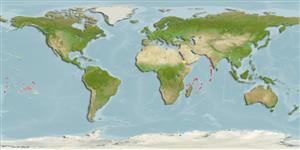>
Holocentriformes (Squirrelfishes, soldierfishes) >
Holocentridae (Squirrelfishes, soldierfishes) > Holocentrinae
Etymology: Sargocentron: Greek, sargos = sargus + Greek, kentron = sting (Ref. 45335); inaequalis: From the unequal length of the serrae in the series along the posterior edge of the preopercle..
More on authors: Randall & Heemstra.
Environment: milieu / climate zone / depth range / distribution range
Ecologia
marinhas associadas(os) a recifes; intervalo de profundidade 6 - 10 m (Ref. 7459). Tropical
Western Indian Ocean: Chagos Archipelago, Comoro Islands, Seychelles, Reunion. Central Pacific: Line Islands (Kiribati).
Tamanho / Peso / Idade
Maturity: Lm ? range ? - ? cm
Max length : 11.3 cm SL macho/indeterminado; (Ref. 27370)
Espinhos dorsais (total): 11; Raios dorsais (total): 13; Espinhos anais 4; Raios anais : 9. Pale red in color with edges of the scales darker red; a narrow darker red stripe between scale rows of the body; pelvis and spinous dorsal fines red. 4-5 oblique rows of scales on cheek. Body depth 2.5-2.8 in SL; head length 2.5-2.7 in SL; short snout, 4.25-4.85 in head length; interorbital width 4.75-5.0 in head length; lower jaw slightly inferior. Maxilla extending to between verticals at anterior edge of the iris and slightly posterior to center of the eye, upper jaw length 2.5-2.8 in head length; rounded anterior end of nasal bone; moderately large nasal fossa spineless; retrorse spine on nasal bone between the nasal fossa and edge of premaxillary groove; median edge of nasal bone (premaxillary groove margin) with a small recumbent retrorse spine; preopercular spine, 1.5-1.9 in orbit diameter; posterior edge of preopercle with unequal spinules, some 3-4 times longer than adjacent spines, and few in number (21-23, 6.75-7.2 cm SL); longest dorsal spines, 1.85-2.25 in head length; third anal spine 1.6-1.9 in head length. Rounded caudal fin lobes (Ref. 27370).
An uncommon inhabitant of lagoon reefs (Ref. 9710). Seen only from poison stations (Ref. 9710).
Ciclo de vida ou comportamento de acasalamento
Maturidade | Reprodução | Desova | Ovos | Fecundidade | Larvas
Randall, J.E., 1998. Revision of the Indo-Pacific squirrelfishes (Beryciformes: Holocentridae: Holocentrinae) of the genus Sargocentron, with descriptions of four new species. Indo-Pac. Fish. (27):105 p. (Ref. 27370)
Status na Lista Vermelha da UICN (Ref. 130435)
Ameaça para os humanos
Harmless
Uso pelos humanos
Mais informação
Nomes comunsSinônimosMetabolismoPredadoresEcotoxicologiaReproduçãoMaturidadeDesovaAgregação de desovaFecundidadeOvosDesenvolvimento dos ovos
Idade/TamanhoCrescimentoPeso-comprimentoComprimento-comprimentoFrequências de comprimentoMorfometriaMorfologiaLarvasDinâmica larvalRecrutamentoAbundânciaBRUVS
ReferênciasAquaculturaPerfil para aquaculturaEstirpesGenéticaElectrophoresesHereditariedadeDoençasProcessamentoNutrientsConversão de massa
ColaboradoresFotosStamps, Coins Misc.SonsCiguateraVelocidadeTipo de nataçãoÁrea branquialOtólitosCérebrosVisão
Ferramentas
Relatórios especiais
Baixar XML
Fontes da internet
Estimates based on models
Preferred temperature (Ref.
123201): 25.7 - 29, mean 27.7 °C (based on 339 cells).
Índice de diversidade filogenética (Ref.
82804): PD
50 = 0.5000 [Uniqueness, from 0.5 = low to 2.0 = high].
Bayesian length-weight: a=0.01622 (0.00774 - 0.03400), b=2.97 (2.80 - 3.14), in cm total length, based on LWR estimates for this Genus-body shape (Ref.
93245).
Nível Trófico (Ref.
69278): 3.5 ±0.5 se; based on size and trophs of closest relatives
Resiliência (Ref.
120179): Elevada, tempo mínimo de duplicação da população menor que 15 meses (Preliminary K or Fecundity.).
Fishing Vulnerability (Ref.
59153): Low vulnerability (10 of 100).
